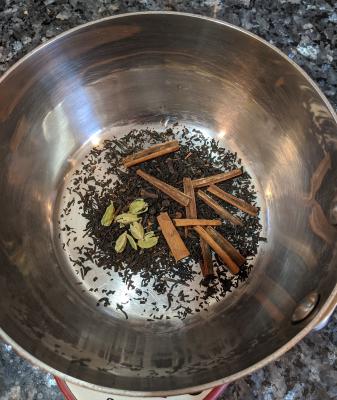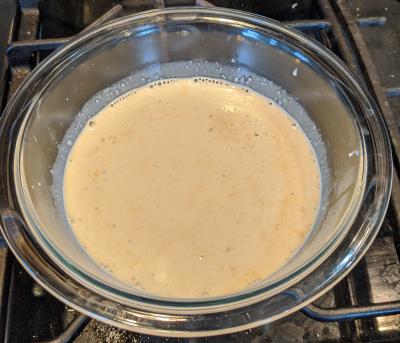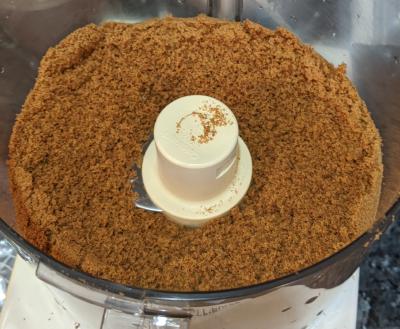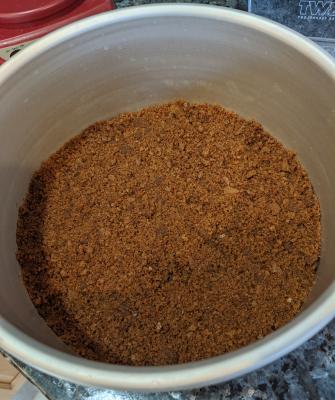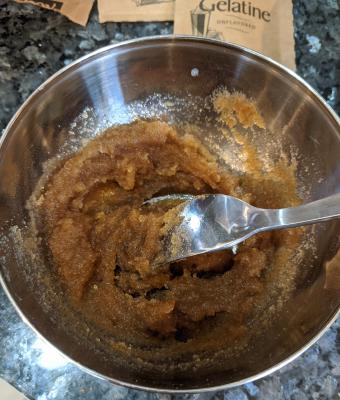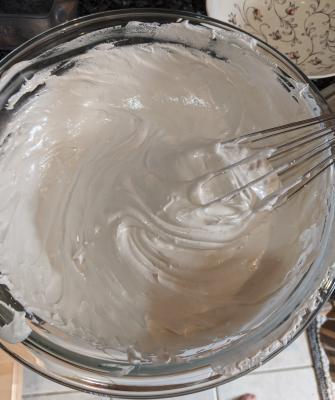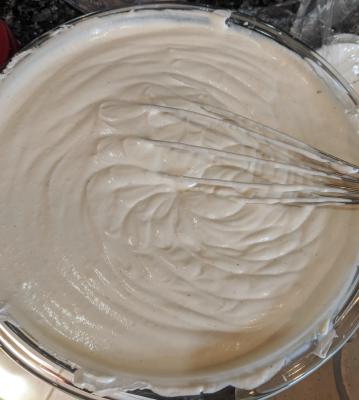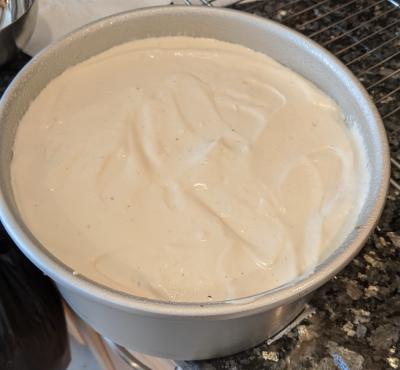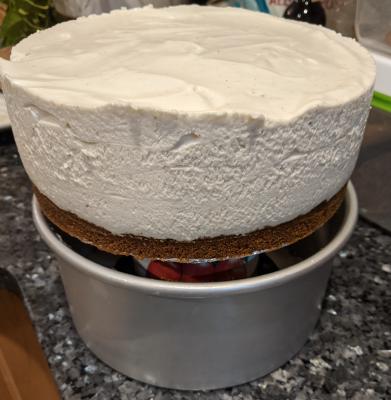Chai Yogurt Cheesecake
Published on Wednesday, December 25, 2019The inspiration for this recipe came from a class I took at Culinaria that featured a pumpkin cheesecake with a pepparkakor crust. While I’m not a big fan of New York-style cheesecake custard or of pumpkin-flavored things, I loved the crust made from butter and pepparkakor crumbs. The warm spices used in the cookies (cardamom, cinnamon, and cloves) are also traditionally used in chai tea, so I wanted to try building a cheesecake around chai-infused cream. I found a recipe for chai infused pots de crème from Suvir Saran and another for a unique skyr “cheesecake” from Stella Parks that promised a lighter custard.
In the end, the chai flavor did complement the pepparkakor crust nicely, but the cream was lighter in both color and flavor than I had been anticipating. What worked fabulously, however, was the yogurt-based custard technique developed by Stella Parks. The cheesecake filling retained the tartness of the yogurt and set into an impossibly light and airy custard, almost like a fine mousse.
Next time, I might try to complement the flavor of the yogurt rather than the crust by adding kesar mango pulp instead of infusing the cream.
Ingredients
For the crust
- 250 grams pepparkakor or gingerbread crumbs (I used this recipe, but any crisp gingerbread will do)
- 55 grams butter (melted and warm)
- 0.25 teaspoons salt
For the custard
- 340 grams heavy cream
- 1 stick cinnamon (broken in half)
- 1 tablespoon loose leaf black tea (Keemun or Darjeeling works best)
- 6 pods cardamom (lightly smushed in a mortar and pestle to open the husk)
- 5 cloves (whole)
- 4 black peppercorns (whole)
- 14 grams gelatin (unflavored)
- 30 grams water (room temperature)
- 22 grams vanilla extract
- 680 grams greek yogurt (make sure to use a variety that is not artificially thickened)
- 6 egg whites
- 200 grams sugar
- 2 grams salt
Directions
Infuse the tea and chai spices into the cream
- Place the cinnamon, cardamom, cloves, peppercorns, and tea in a small saucepan.
- Add the heavy cream and bring to a boil.
- Remove from heat, cover, and let steep for 15 minutes.
- Strain infused cream into bowl, cover loosely with plastic wrap, and place in refrigerator. Allow cream to cool for at least 30 minutes.
Prepare the crust and pan
- Wrap the bottom insert of the loose bottom pan in aluminum foil.
- Grease the interior of the pan with cooking spray.
- Pulse pepparkakor cookies into a rough crumb
- Mix cookie crumbs, salt, and melted butter.
- Press the crumb mixture into an even layer at the base of the pan.
Make the custard
The custard for this cheesecake uses a Swiss meringue based on Stella Parks' Rethinking Swiss Meringue as its base. I recommend reading her article first so you can get a better idea of what the meringue should look like at various stages.
- Mix the gelatin, water, and vanilla together in a small bowl until no lumps remain. Set this bowl aside until the meringue is finished.
- Whip the chai infused cream and greek yogurt together in a stand mixer until the mixture can hold a stiff peak. (The peaks will be less stiff than those of unadulterated whipped cream due to the yogurt. This step should take about five minutes.)
- Scrape mixture into a separate bowl and clean the stand mixer bowl thoroughly. (Any stray fat still in the mixer bowl could prevent the meringue from stiffening.)
- Combine the sugar, salt, and egg whites in a large, heat-safe bowl.
- Fill a small saucepan with 4-5 centimeters are water, then bring to a boil.
- Lower the heat on the water to a simmer, then place the bowl over the water. The base of the bowl should not be touching the water (you want to heat the bowl with steam, not water) but should trap steam rising off the water. (If you don't have a heat-safe bowl and saucepan that fit together in this way, take a look at Stella Parks' foil ring technique in Rethinking Swiss Meringue.)
- Continuously stir and scrape the sides of the bowl with a flexible spatula until the mixture reaches 175° Fahrenheit.
- Scrape mixture into the stand mixer bowl.
- Mix at high speed with a whisk attachment until the merignue is opaque, glossy, and stiff (about four minutes)
- While the meringue is mixing, liquefy the gelatin mixture prepare eariler by holding it over the simmering water and whisking with a fork. This mixture should not exceed 212° Fahrenheit.
- Scrape one half of the prepared meringue into a large bowl, add the liquid gelatin mixture, and immediately combine with a balloon whisk to evenly disperse gelatin before it congeals.
- Add remaining meringue to mixture and whisk together, then do the same with the cream and yogurt mixture.
Form the cheesecake
- Scrape the custard mixture into the prepared cheesecake pan.
- Cover pan loosely with plastic wrap or foil and refrigerate for at least six hours.
- Remove cheesecake from refrigerator and run the dull edge of a butter knife or an offset spatula around the interior edge of the pan.
- Place the pan over a can of tomatoes or mason jar and pull the outer ring of the pan straight down with both hands.
- Serve a slice immediately to yourself and 15 of your closest friends! Alternatively, you can keep the cheesecake wrapped or covered in the refrigerator for up to a week.
